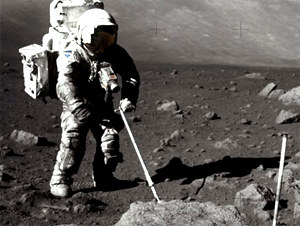Significant water on the moon
 Washington - Significant amounts of water were found in a crater on the moon in an experiment that crashed a rocket into the lunar surface last month, NASA scientists say.
Washington - Significant amounts of water were found in a crater on the moon in an experiment that crashed a rocket into the lunar surface last month, NASA scientists say.
Scientists have long suspected that measurements of hydrogen around the moon indicated trace amounts of ice. Data from other spacecraft last month also showed small amounts of water across the moon's surface.
But the findings by the Lunar Crater Observation and Sensing Satellite (LCROSS) experiment prove that water is even more abundant in the moon's craters than expected, unlocking a new chapter in the history of lunar science, NASA officials said Friday.
"This is not your father's moon," Greg Delory, a University of California at Berkeley scientist, said of the discovery's importance. "Rather than a dead and unchanging world, it could in fact be a very dynamic and changing one."
The water kicked up by the rocket's impact could fill about a dozen 8-litre buckets, said project scientist Anthony Colaprete.
The dramatic experiment last month crashed the LCROSS spacecraft into the moon, sending a huge plume of dust 10 kilometres above the surface to gather data about ice that was suspected to be hidden in the perpetually dark lunar craters.
Major telescopes around the world were aimed at the Cabeus crater on the moon's south pole to capture data from the dust plume.
Astronomers will now work to determine the source of the water, which could have been deposited by comets hitting the moon, be a result of solar winds or even been generated on the moon's surface itself, Delory said.
Information gleaned from the water could provide important clues about the history of the moon and the solar system at large, much as evidence frozen in Earth's polar regions has given clues about the planet's history and climate, scientists said.
"It's really like the dusty attic of the solar system," said NASA scientist Mike Wargo.
NASA scientists said that it is possible for frozen water to have remained in the moon's craters for billions of years, because the bottoms of the craters are never reached by sunlight and protect any ice from evaporation into the thin lunar atmosphere.
The LCROSS mission and its companion Lunar Reconnaissance Orbiter satellite are designed to prepare for a return by humans to the moon, determining where conditions might be most conducive to establish long-term bases.
The find could have implications for how future exploration missions work, providing a possible source of drinkable water or even being turned into breathable oxygen or rocket fuel, Wargo said.
The rocket's impact was designed to mimic that of the large, natural asteroids that slam into the moon several times a month.
The NASA probe targeted a 100-kilometre wide, 4-kilometre deep crater and was timed to strike when lighting conditions are ideal for observing the impact. The 585-kilogramme craft created an impact crater about 2 metres deep. (dpa)